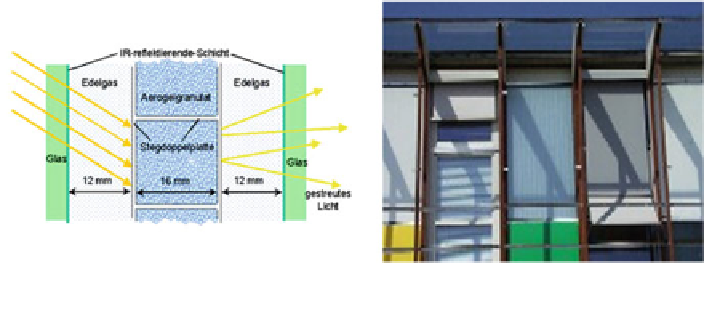Civil Engineering Reference
In-Depth Information
(Airglass A.B) in Sweden, but advanced glazing systems with monolithic aerogel
have still not penetrated the market (Duer and Svendsen
1998
; Jensen et al.
2004
;
Schultz and Jensen
2008
). At the same time, granular translucent aerogels were
manufactured, and, starting from 2005, many daylighting systems (polycarbonate
panels, structural panels for continuous façades, insulated glasses) with translucent
granular aerogel in interspace are available on the market (Rigacci et al.
2004
).
They are the most promising solutions, despite the high cost; nowadays, a
reference market price for a cubic metre of granular silica aerogel is in the order of
4,000 US$ (2008), but it could drop below 1,500 US$ by the year 2020, due of the
expected increasing of commercialization. It means that a 15-mm-thick interspace
filled with granular aerogels could now have a cost of 60 US$/m
2
, that could
become 22.5 US$/m
2
in 2020.
The first daylighting system with granular aerogel in interspace consisted of a
double-skin sheet of polymethyl methacrylate (PMMA) (Reim et al.
2002
). Two
types of granular aerogel were used in prototype windows: semi-transparent, con-
sisting of rather regular spheres, and high translucent granulates, consisting of
irregularly fractured pieces spheres. The optical properties measured with an inte-
grating sphere (400-2,000 nm wavelength range) showed a decrease in transmission
with a decrease in wavelength below 600 nm; the investigated fractured aerogel
samples showed a higher transmittance than the regular ones, both in the visible and
solar range. A prototype of the new glazing with high translucent granular aerogel
was for the first time integrated into the façade of the ZAE building (Bayerisches
Zentrum für Angewandte Energieforschung, Fig.
8
) in Wurzburg, Germany (2000).
Moreover, in order to optimize the thermal insulation, the sheet was mounted
between two low-e coated glass panes (emissivity equal to 0.03 or 0.08), and argon
or krypton were used as filling gases. Depending on the filling, the low-e coating
emissivity and granular aerogel kind, a U-value in the 0.37-0.56 W/m
2
K range,
and a total solar energy transmittance (solar factor, g) in the 17-45 % range were
obtained (Reim et al.
2005
).
Also the company Scobalit AG (Switzerland) was a pioneer in aerogel-filled
composite panels for translucent daylighting applications. The developed system
Fig. 8 The façade of the ZAE (Bayerisches Zentrum für Angewandte Energieforschung): the
first example of the use of PMMA systems with granular aerogels (2000)

